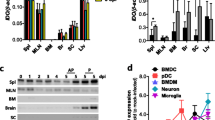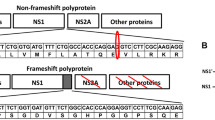Abstract
Japanese encephalitis virus (JEV) is a mosquito-borne flavivirus, which causes the most commonly diagnosed viral encephalitis named Japanese encephalitis (JE) in the world with an unclear pathogenesis. Axl, a receptor tyrosine kinase from TAM family, plays crucial role in many inflammatory diseases. We have previously discovered that Axl deficiency resulted in more severe body weight loss in mice during JEV infection, which we speculate is due to the anti-inflammatory effect of Axl during JE. Currently, the role of Axl in regulating the neuroinflammation and brain damage during JE has not been investigated yet. In this study, by using Axl deficient and heterozygous control mice, we discovered that Axl deficient mice displayed accelerated JE progression and exacerbated brain damage characterized by increased neural cell death, extended infiltration of inflammatory cells, and enhanced production of pro-inflammatory cytokines, in comparison to control mice. Additionally, consistent with our previous report, Axl deficiency had no impact on the infection and target cell tropism of JEV in brain. Taken together, our results suggest that Axl plays an anti-inflammatory and neuroprotective role during the pathogenesis of JE.










Similar content being viewed by others
References
Amicizia D, Zangrillo F, Lai PL, Iovine M, Panatto D (2018) Overview of Japanese encephalitis disease and its prevention. Focus on IC51 vaccine (IXIARO ®). J Prev Med Hyg 59:E99–E107
Chen J, Yang YF, Yang Y, Zou P, He Y, Shui SL, Cui YR, Bai R, Liang YJ, Hu Y, Jiang B, Lu L, Zhang X, Liu J, Xu J (2018) AXL promotes Zika virus infection in astrocytes by antagonizing type I interferon signalling. Nat Microbiol 3:302–309
Hirschi KM, Tsai KYF, Davis T, Clark JC, Knowlton MN, Bikman BT, Reynolds PR, Arroyo JA (2019) Growth arrest specific protein (Gas)-6/AXL signaling induces preeclampsia (PE) in rats. Biol Reprod. https://doi.org/10.1093/biolre/ioz140
Li Q, Lu Q, Lu H, Tian S (2013) Systemic autoimmunity in TAM triple knockout mice causes inflammatory brain damage and cell death. PLoS ONE 8:e64812
Meertens L, Labeau A, Dejarnac O, Cipriani S, Sinigaglia L, Bonnet-Madin L, Le Charpentier T, Hafirassou ML, Zamborlini A, Cao-Lormeau VM, Coulpier M, Misse D, Jouvenet N, Tabibiazar R, Gressens P, Schwartz O, Amara A (2017) Axl mediates ZIKA virus entry in human glial cells and modulates innate immune responses. Cell Rep 18:324–333
Moller-Tank S, Maury W (2014) Phosphatidylserine receptors: enhancers of enveloped virus entry and infection. Virology 468–470:565–580
Peng CK, Wu CP, Lin JY, Peng SC, Lee CH, Huang KL, Shen CH (2019) Gas6/Axl signaling attenuates alveolar inflammation in ischemia-reperfusion-induced acute lung injury by up-regulating SOCS3-mediated pathway. PLoS ONE 14:e0219788
Ray AK, DuBois JC, Gruber RC, Guzik HM, Gulinello ME, Perumal G, Raine C, Kozakiewicz L, Williamson J, Shafit-Zagardo B (2017) Loss of Gas6 and Axl signaling results in extensive axonal damage, motor deficits, prolonged neuroinflammation, and less remyelination following cuprizone exposure. Glia 65:2051–2069
Richard AS, Shim BS, Kwon YC, Zhang R, Otsuka Y, Schmitt K, Berri F, Diamond MS, Choe H (2017) AXL-dependent infection of human fetal endothelial cells distinguishes Zika virus from other pathogenic flaviviruses. Proc Natl Acad Sci U S A 114:2024–2029
Rothlin CV, Carrera-Silva EA, Bosurgi L, Ghosh S (2015) TAM receptor signaling in immune homeostasis. Annu Rev Immunol 33:355–391
Rothlin CV, Ghosh S, Zuniga EI, Oldstone MB, Lemke G (2007) TAM receptors are pleiotropic inhibitors of the innate immune response. Cell 131:1124–1136
Seitz HM, Camenisch TD, Lemke G, Earp HS, Matsushima GK (2007) Macrophages and dendritic cells use different Axl/Mertk/Tyro3 receptors in clearance of apoptotic cells. J Immunol 178:5635–5642
Shafit-Zagardo B, Gruber RC, DuBois JC (2018) The role of TAM family receptors and ligands in the nervous system: from development to pathobiology. Pharmacol Ther 188:97–117
Sheng Z, Gao N, Cui X, Fan D, Chen H, Wu N, Wei J, An J (2016) Electroporation enhances protective immune response of a DNA vaccine against Japanese encephalitis in mice and pigs. Vaccine 34:5751–5757
Siemann DN, Strange DP, Maharaj PN, Shi PY, Verma S (2017) Zika virus infects human sertoli cells and modulates the integrity of the in vitro blood-testis barrier model. J Virol 91
Strange DP, Jiyarom B, Pourhabibi Zarandi N, Xie X, Baker C, Sadri-Ardekani H, Shi PY, Verma S (2019) Axl Promotes Zika Virus Entry and Modulates the Antiviral State of Human Sertoli Cells. mBio 10
Sun B, Qi N, Shang T, Wu H, Deng T, Han D (2010) Sertoli cell-initiated testicular innate immune response through toll-like receptor-3 activation is negatively regulated by Tyro3, Axl, and mer receptors. Endocrinology 151:2886–2897
Sun X, Guan H, Peng S, Zhao Y, Zhang L, Wang X, Li C, Shan Z, Teng W (2019) Growth arrest-specific protein 6 (Gas6) attenuates inflammatory injury and apoptosis in iodine-induced NOD.H-2(h4) mice. Int Immunopharmacol 73:333–342
Turtle L, Solomon T (2018) Japanese encephalitis - the prospects for new treatments. Nat Rev Neurol 14:298–313
Wang R, Liao X, Fan D, Wang L, Song J, Feng K, Li M, Wang P, Chen H, An J (2018) Maternal immunization with a DNA vaccine candidate elicits specific passive protection against post-natal Zika virus infection in immunocompetent BALB/c mice. Vaccine 36:3522–3532
Waterborg CEJ, Broeren MGA, Blaney Davidson EN, Koenders MI, van Lent P, van den Berg WB, van der Kraan PM, van de Loo FAJ (2019) The level of synovial AXL expression determines the outcome of inflammatory arthritis, possibly depending on the upstream role of TGF-beta1. Rheumatology (Oxford) 58:536–546
Weinger JG, Brosnan CF, Loudig O, Goldberg MF, Macian F, Arnett HA, Prieto AL, Tsiperson V, Shafit-Zagardo B (2011) Loss of the receptor tyrosine kinase Axl leads to enhanced inflammation in the CNS and delayed removal of myelin debris during experimental autoimmune encephalomyelitis. J Neuroinflammation 8:49
Wu G, McBride DW, Zhang JH (2018) Axl activation attenuates neuroinflammation by inhibiting the TLR/TRAF/NF-kappaB pathway after MCAO in rats. Neurobiol Dis 110:59–67
Yuan A, Rao MV, Veeranna, Nixon RA (2017) Neurofilaments and Neurofilament proteins in health and disease. Cold Spring Harb Perspect Biol 9:a018309
Zhen Y, Lee IJ, Finkelman FD, Shao WH (2018) Targeted inhibition of Axl receptor tyrosine kinase ameliorates anti-GBM-induced lupus-like nephritis. J Autoimmun 93:37–44
Acknowledgements
This work was supported by the National Natural Science Foundation of China (81671971, 81871641, 81972979, U1902210 and U1602223), the Scientific Research Plan of the Beijing Municipal Education Committee (KM201710025002), and the Key Project of Beijing Natural Science Foundation B (KZ201810025035), the Support Project of High-level Teachers in Beijing Municipal Universities in the Period of 13th Five-year Plan (IDHT20190510).
Author information
Authors and Affiliations
Contributions
ZY Wang designed and performed most of the experiments, analyzed the data, wrote and reviewed the manuscript. ZD Zhen performed flow cytometry experiments and TUNEL staining. DY Fan maintained cells, viruses, and reagents. PG Wang and J An conceived the project, analyzed the data, and finalized the manuscript.
Corresponding author
Ethics declarations
Conflict of interest
The authors declare that they have no conflict of interest.
Animal and Human Rights Statement
All institutional and national guidelines for the care and use of laboratory animals were followed, and all the animal experiments were approved by the Experimental Animal Welfare and Animal Ethics Committee of Capital Medical University, Beijing, China (permission code: AEEI-2015–048; permission date: April 20, 2015).
Rights and permissions
About this article
Cite this article
Wang, ZY., Zhen, ZD., Fan, DY. et al. Axl Alleviates Neuroinflammation and Delays Japanese Encephalitis Progression in Mice. Virol. Sin. 36, 667–677 (2021). https://doi.org/10.1007/s12250-020-00342-y
Received:
Accepted:
Published:
Issue Date:
DOI: https://doi.org/10.1007/s12250-020-00342-y




